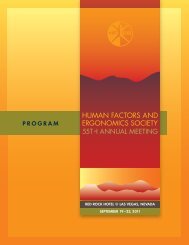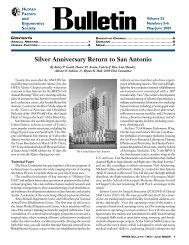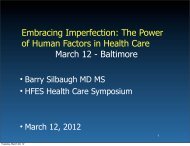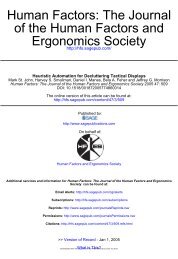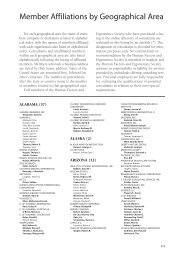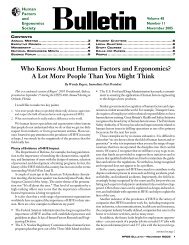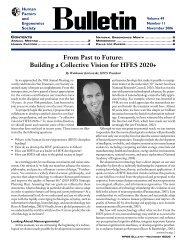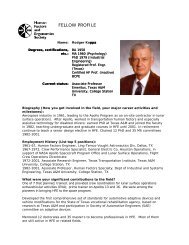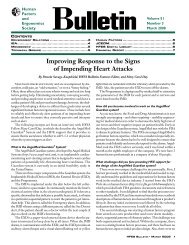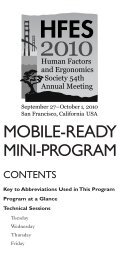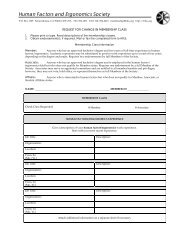carlow - Human Factors and Ergonomics Society
carlow - Human Factors and Ergonomics Society
carlow - Human Factors and Ergonomics Society
You also want an ePaper? Increase the reach of your titles
YUMPU automatically turns print PDFs into web optimized ePapers that Google loves.
PD4 – NEW CONCEPTS IN PRODUCT DESIGN<br />
Lecture<br />
Wednesday, September 29, 2010, 10:30 a.m. to<br />
12:00 noon<br />
Hospitality Room (Atrium Lobby Level)<br />
Product Design<br />
Chair: Enid Montague, U. of Wisconsin-Madison;<br />
Cochair: Sharon Joines, North Carolina State U.<br />
1. Tareq Z. Ahram <strong>and</strong> Waldemar Karwowski, Inst.<br />
for Advanced Systems Engineering; Ben Amaba,<br />
IBM Industry Solutions, User-Centered Systems<br />
Engineering & Knowledge Management<br />
Framework for Design & Modeling of Future<br />
Smart Cities<br />
2. Bertina Lee <strong>and</strong> Carolyn G. MacGregor, U. of<br />
Waterloo, The Emotional Impact of Surface<br />
<strong>and</strong> Prototyping Properties in Product Design<br />
3. Yusuke Yamani, Jason S. McCarley, <strong>and</strong> Deana<br />
McDonagh, U. of Illinois at Urbana-Champaign,<br />
Transgenerational Communication Through<br />
Affective Imagery in Mood Boards<br />
4. Danielle Lottridge <strong>and</strong> Mark Chignell, U. of<br />
Toronto, Sliders Rate Valence But Not<br />
Arousal: Psychometrics of Sliders for Self-<br />
Reported Emotion<br />
5. Hugh E. McLoone, Microsoft Corp., Product<br />
Archetype of Personal Computers as an<br />
Expression of the Collective Unconsciousness<br />
of People on Their Hero’s Journey<br />
POS2 – POSTERS 2<br />
Poster Session<br />
Wednesday, September 29, 2010, 10:30 a.m. to<br />
12:00 noon<br />
Pacific Concourse A–C (Pacific Concourse Level)<br />
Posters<br />
Chair: Kristin Oleson, U. of Central Florida; Cochair:<br />
Rajaram Bhagavathula, Virginia Tech<br />
Poster sessions are 90 minutes only; presenters are<br />
required to be present throughout the session.<br />
Robotics/Unihabited Vehicles<br />
1. Webb Stacy, Aptima Inc.; Joseph V. Cohn,<br />
Defense Advanced Research Projects Agency;<br />
Alex<strong>and</strong>ra Geyer, Aptima Inc.; Tracey Wheeler,<br />
System Planning Corp., A Cognition-Based<br />
Control System for Autonomous Robots<br />
2. Elizabeth Phillips, Javier Rivera, Thomas<br />
Fincannon, Aaron S. Dietz, <strong>and</strong> Ariel Afek, U. of<br />
Central Florida, The Relationship of Closure<br />
Speed <strong>and</strong> Training on Target Identification<br />
for Unmanned Vehicle Operators<br />
3. Jessie Y. C. Chen <strong>and</strong> Michael J. Barnes, U.S.<br />
Army Research Lab, Supervisory Control of<br />
Robots Using RoboLeader<br />
4. Jessie Y. C. Chen, U.S. Army Research Lab;<br />
Razia N. V. Oden, National Research Council;<br />
Caitlin Kenny, U. of Central Florida; John O.<br />
Merritt, The Merritt Group, Stereoscopic<br />
Displays for Robot Teleoperation <strong>and</strong><br />
Simulated Driving<br />
5. Michael J. Barnes, U.S. Army Research Lab;<br />
Florian Jentsch, U. of Central Florida; Jessie Y. C.<br />
Chen, Ellen Haas, <strong>and</strong> Keryl A. Cosenzo, U.S.<br />
Army Research Lab, Soldier-Robot Teams: Six<br />
Years of Research<br />
Automation<br />
6. Tyler Shaw, Adam Emfield, Andre Garcia, <strong>and</strong><br />
Ewart de Visser, George Mason U.; Chris Miller,<br />
Smart Information Flow Technologies; Raja<br />
Parasuraman, George Mason U.; Lisa Fern, NASA<br />
Ames/San Jose State U. Research Foundation,<br />
Evaluating the Benefits <strong>and</strong> Potential Costs<br />
of Automation Delegation for Supervisory<br />
Control of Multiple UAVs<br />
7. Jeremy Schwark, Igor Dolgov, William Graves,<br />
<strong>and</strong> Daniel Hor, New Mexico State U., The<br />
Influence of Perceived Task Difficulty <strong>and</strong><br />
Importance on Automation Use<br />
8. Rylan Clark, Aana M. Ingebritsen, <strong>and</strong> Ernesto A.<br />
Bustamante, U. of Idaho, Differential Effects<br />
of Likelihood Alarm Technology <strong>and</strong> False-<br />
Alarm vs. Miss-Prone Automation on<br />
Decision-Making Accuracy <strong>and</strong> Bias<br />
9. R<strong>and</strong>y B. Davenport <strong>and</strong> Ernesto A. Bustamante,<br />
U. of Idaho, Effects of False-Alarm vs. Miss-<br />
Prone Automation <strong>and</strong> Likelihood Alarm<br />
Technology on Trust, Reliance, <strong>and</strong> Compliance<br />
in a Miss-Prone Task<br />
Aviation<br />
10. Rosemarie Reynolds, Elizabeth L.<br />
Blickensderfer, Adria Martin, <strong>and</strong> Kevin<br />
Rossignon, Embry Riddle Aeronautical U.,<br />
<strong>Human</strong> <strong>Factors</strong> Training in Aviation<br />
Maintenance: Impact on Incident Rates<br />
11. Kathleen L. Mosier, Paula Rettenmaier, Matthew<br />
McDearmid, Jordan Wilson, Stanton Mak, <strong>and</strong><br />
Lakshmi Raj, San Francisco State U.; Judith<br />
Orasanu, NASA Ames Research Ctr., Pilot/ATC<br />
Communication Conflicts: Implications for<br />
NextGen<br />
12. Kara Latorella, NASA Langley; Kyle Ellis,<br />
U.Iowa; William Lynn, NASA Langley; Dennis<br />
Frasca, PSI International Inc.; Daniel Burdette,<br />
Lockheed Martin Inc.; Alan Douglas, PSI<br />
International Inc., Dual Oculometer System<br />
for Aircraft Crew Assessment<br />
SEPTEMBER 29 – WEDNESDAY 23<br />
Wednesday<br />
Sept. 29



